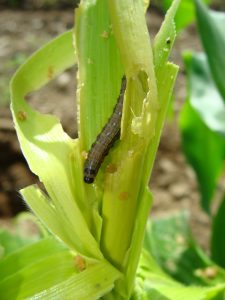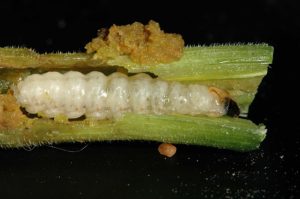Sweet Corn IPM Newsletter No. 2 – July 1, 2022

University of Maine Sweet Corn IPM Newsletter No. 2 – July 1, 2022
CORN PESTS ACTIVE IN EARLY FIELDS
European Corn Borer, Corn Earworm & Fall Armyworm Moths Caught This Week
SAVE THE DATE: Highmoor Farm Summer Tour and BBQ July 27 @1:30-7:30. More details soon!
SITUATION
Early corn planted under plastic mulch or rowcovers is starting to silk in southern Maine, while earl to mid-season corn is now between whorl and pre-tassel. Most fields are very dry if they are not being irrigated, but we have only seen a little drought stress on plants so far. All three of the major corn pests were found in our traps this week, meaning a fairly early arrival for corn earworm and fall armyworm. There is very little silking corn available now for earworm to threaten, and cool nights predicted in the coming days should keep moth activity low.
European corn borer: Larval feeding injury was over the 15% control threshold for pre-tassel corn at fields in Sabattus and Biddeford this week, although feeding activity was observed in most fields. Sprays during the pre-tassel stage, when both moths and larvae are present, can control larvae before they move into the stalks and ears where they will be protected. Once corn reaches the silk stage, sprays may be based on the number of moths caught in pheromone traps. Moths will lay eggs on flag leaves of silking corn, and the larvae can move into the ears without leaving visible feeding injury. If more than five moths are caught during a week in silking corn, a spray is recommended. An early silking field in Dayton was over the 3-moth threshold, but it was also put on a spray interval for corn earworm, so no additional sprays should be necessary.
Corn earworm: The early arrival of corn earworm this week is only a concern for fields with corn in the silk stage. Fields not yet in silk do not need to be protected from corn earworm. When corn earworm moths cannot find silking corn to deposit their eggs on, they may lay eggs on the leaves or tassels of younger corn. The larvae will feed on the foliage and tassels, similar to armyworm. This damage should be counted, along with any borer or armyworm damage, to determine if a pre-silking spray is warranted.

Fall armyworm: A few fall armyworm moths were caught in pheromone traps this week, but no larval feeding damage on leaves or tassels has been found in fields we’ve scouted. Young larvae can move into the ears through the silk channel, behaving similarly to corn earworm. If more than 3 moths are caught in pheromone traps in a field with silking corn, a spray would be recommended, if it is not already being sprayed for corn earworm. The three-moth threshold was exceeded in Biddeford, but there was no corn in silk at that site.

Squash vine borer: Pheromone traps were set up in pumpkin and squash traps this week. We are getting reports of vine borer activity in MA and NH. Growers with squash should be on the lookout for vine borer symptoms and protect plants if moths or damage are seen. See the New England Vegetable Management Guide for control options.
Highmoor Farm, the Maine Agriculture and Forest Experiment Station in Monmouth, Maine will hold a summer tour and BBQ dinner with an educational program on Wednesday, July 27, from 1:30 to 7:30 p.m. More details to follow…
Sincerely,
David T. Handley
Vegetable and Small Fruit Specialist
Highmoor Farm UMaine Extension Diagnostic
P.O. Box 179 Research Lab, Pest Mgmt. Unit
52 U.S. Route 202 17 Godfrey Drive
Monmouth, ME 04259 Orono, ME 04473
207.933.2100 1.800.287.0279
Sweet Corn IPM Weekly Scouting Summary
| Location | CEW
Moths |
ECB
Moths |
FAW
Moths |
%Feeding
Damage |
Recommendations / Comments |
| Biddeford | 1 | 0 | 1 | 25% | One spray for ECB feeding on pre-tassel corn |
| Bowdoinham | 1 | 1 | 0 | 4% | No spray recommended |
| Cape Elizabeth | 0 | 4 | 3 | No spray recommended (no silking corn) | |
| Dayton I | 0 | 3 | 0 | 11% | No spray recommended |
| Dayton II | 3 | 17 | 1 | 6% | 6-day spray interval for silking corn |
| Farmington | 0 | 6 | 0 | 3% | No spray recommended (no silking corn) |
| Lewiston | 0 | 22 | 0 | 1% | No spray recommended (no silking corn) |
| Lewiston II | 3 | 3 | 0 | 0% | No spray recommended (no silking corn) |
| Oxford | 0 | 0 | 1 | 0% | No spray recommended |
| Sabattus | 0 | 3 | 0 | 15% | One spray for ECB feeding on pre-tassel corn |
| Wayne | 1 | 3 | 1 | 4% | No spray recommended |
| Wells I | 2 | 0 | 1 | 0% | No spray recommended (no silking corn) |
| Wells II | 0 | 1 | 0 | 0% | No spray recommended |
CEW: Corn earworm (Only fresh silking corn should be sprayed for this insect.)
ECB: European corn borer
FAW: Fall armyworm
| European Corn Borer Thresholds
Whorl stage: 30% or more of plants scouted show injury. Pre-tassel-silk: 15% or more of plants scouted show injury. Silk: 5 or more moths caught in pheromone traps in one week. |
Corn Earworm Spray Thresholds for Pheromone Traps
| Moths caught per week | Moths caught per night | Spray interval |
| 0.0 to 1.4 | 0.0 to 0.2 | No spray |
| 1.5 to 3.5 | 0.3 to 0.5 | Spray every 6 days |
| 3.6 to 7.0 | 0.6 to 1.0 | Spray every 5 days |
| 7.1 to 91 | 1.1 to 13.0 | Spray every 4 days |
| More than 91 | More than 13 | Spray every 3 days |
Thresholds apply only to corn with exposed fresh silk. Lengthen spray intervals by
one day if the maximum daily temperature is less than 80°F.
IPM Web Pages:
http://extension.umaine.edu/ipm/
http://www.pestwatch.psu.edu/sweet_corn.htm
https://ag.umass.edu/integrated-pest-management/
Where brand names or company names are used, it is for the reader’s information. No endorsement is implied nor is any discrimination intended against other products with similar ingredients. Always consult product labels for rates, application instructions, and safety precautions. Users of these products assume all associated risks.
The University of Maine is an equal opportunity/affirmative action institution.
